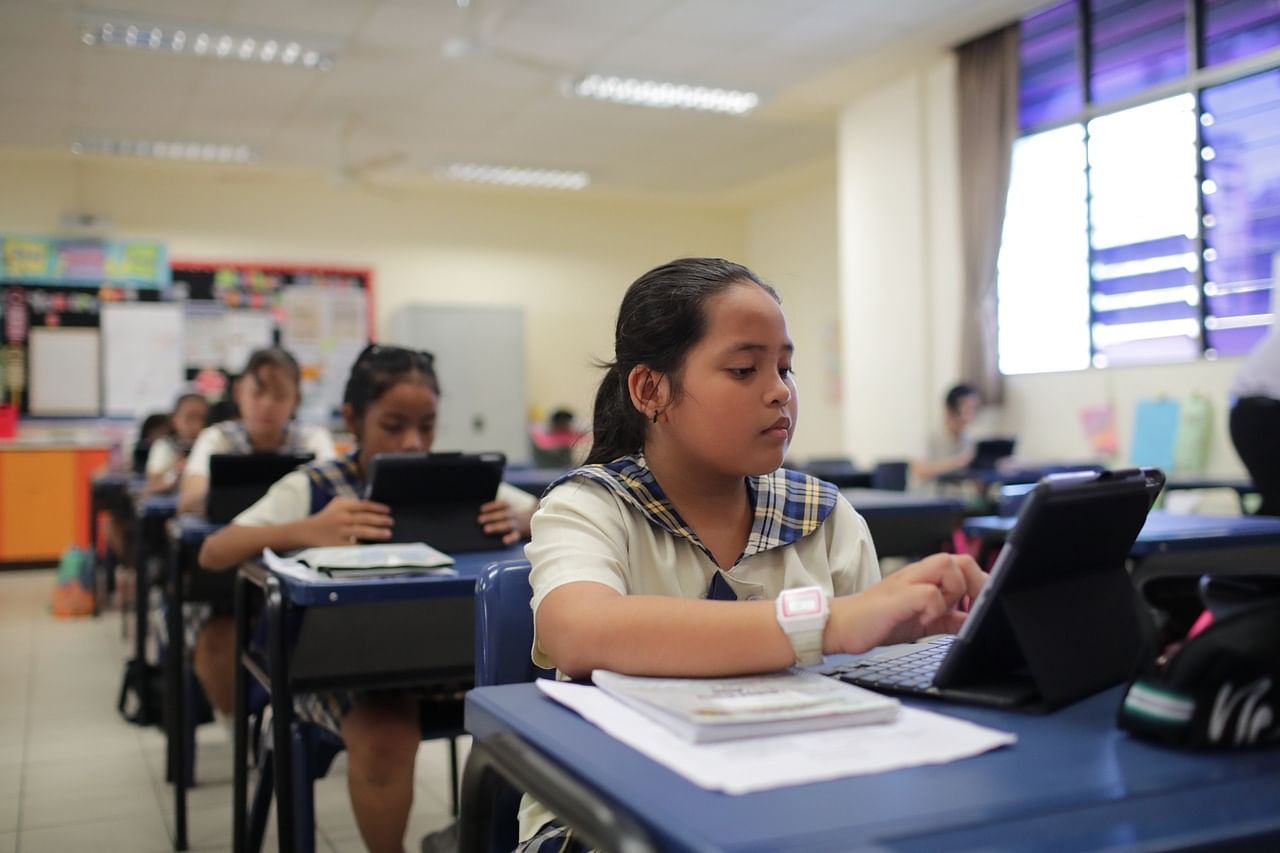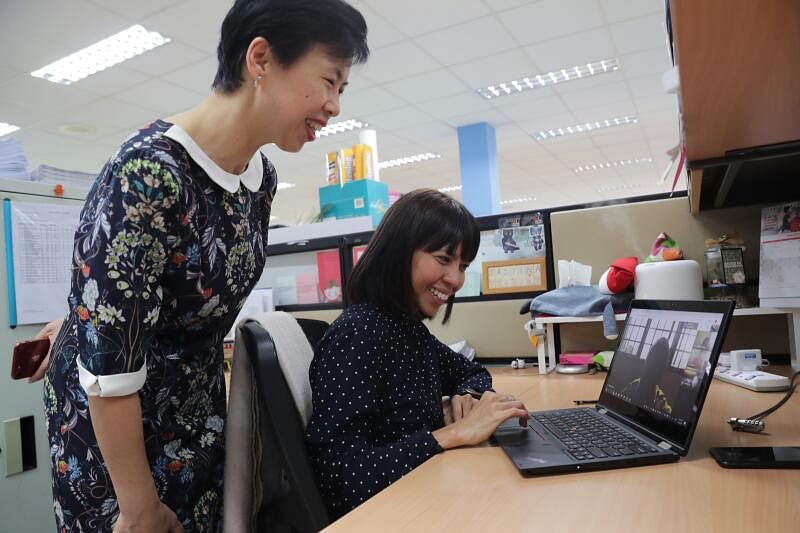Coronavirus: Lessons at home for primary school pupils proceed smoothly, despite teething issues
Sign up now: Get ST's newsletters delivered to your inbox
Jolene Ang, Amelia Teng
Follow topic:
SINGAPORE - Primary school pupils were able to attend school virtually on Wednesday (April 1) - despite some teething issues - as the Education Ministry rolled out home-based learning to prepare families if the Covid-19 situation calls for more of it.
Some 200,000 primary school pupils stayed at home and followed different timetables set by schools. Some logged onto the Singapore Student Learning Space (SLS) - a digital online learning platform developed by the MOE - as early as 7.30am, while others had been told to start their online learning slightly later, at noon, for instance.
The home-based learning combined both e-classes as well as completing assignments and worksheets. Even physical education classes were conducted online - for example, pupils engaged in high-intensity interval training by following an exercise video on YouTube.
Housewife Joanna Tan, 40, who has a Primary 1 daughter and Primary 5 son, said her children shared a laptop and took turns to do their home-based learning, though there were a few technical issues.
"The school gave each level a time slot to log in. In the late morning, the system kept hanging and my son couldn't upload his assignments. But we will try again later in the day," said Mrs Tan, adding that her children also could not access some slides on the learning platform as Web traffic was heavy.
However, she noted that the teacher was quick to reply to parents' queries.
Education Minister Ong Ye Kung said in a Facebook post on Wednesday afternoon that he had received feedback that some students at home had problem logging onto the Student Learning Space.
"Please bear with us as we iron out the tech glitches," said Mr Ong.
"There is a lot of adjustment to be done. Hence it is important to get this started, involving every student, for one day a week," he added.
Thanking parents, students and teachers for stepping up to the rollout, Mr Ong said: "It's not easy, and it's not perfect, but we are tapping on our collective efforts to get this to work during such exceptional times."
Mrs Janeshtha Vaswani, 47, who has a Primary 2 son, said the school had assisted students and parents with SLS password resets over the past few days to get them ready.
Her son used her personal laptop for home-based learning, said Mrs Vaswani, who is an assistant manager at Duke-NUS' assessment and progression department and is working from home this week.
"The good thing is I am home this week, so I can supervise him. But next week, I need to be in office, so it will be a bit challenging to do that. But we shall see," she said.
Mrs Tan said some parents had done trial runs on various platforms on their own before Wednesday in preparation for the virtual sessions.
"We have a parents chat group (for her son's class). Some of us were worried if our old devices, laptops and headphones can support Google Meet, which the school is using. One mum, who is familiar with Google Meet, set up a trial run for us to try out last Saturday," she said.
"It was a very helpful session. Some were having problems downloading the app and logging in, and we were helping each other over WhatsApp."
The MOE announced last Friday that primary schools would conduct home-based learning on Wednesdays, secondary schools on Thursdays, and junior colleges and the Millennia Institute on Fridays.

Nur Shafryanna Binte Henry (P6), one of the students from Stamford Primary School still be going to school, because their parents do not have alternative care arrangements for them. They are in their class for home based learning, supported by teacher, Teo Yin Song, Gerald on 1 April 2020.
PHOTO: ST
A primary school pupil will have four hours of home-based learning each day, a secondary school student will have five hours, and a junior college or centralised institute student will have six hours.
Parents are not required to take over the role of teaching at home, but to support children to learn independently, said the ministry, although younger primary school pupils may need more help.
The MOE encouraged parents to set up a routine with their children on study, meal and rest timings, and set aside an area conducive for learning such as the dining table or study desk.
Meanwhile, schools remain open for a small group of students whose families are unable to arrange for alternative care support.
Minister Ong, who visited Sembawang Primary School on Wednesday, said about 20 children were in the school.
"A few were there because they did not have WiFi at home, others had parents who had to work. Several of the children were ushered to computer labs to do some online learning. Others were in classrooms doing offline reading and assignments," he said on Facebook.
Madam Cassie Fan, principal of Stamford Primary School, told The Straits Times that the school splits its pupils' online learning sessions into two time slots - 8am to 10am for lower primary levels, and 10.30am to 12.30pm for upper primary.
Besides the two hours set aside for e-classes, pupils spent about another two hours completing hardcopy assignments like worksheets and referred to reading materials offline. They could also submit assignments online.
Ms Jastina Putri Marhajas, 40, was one of eight teachers stationed at the school on Wednesday to help pupils whose parents do not have alternative care arrangements, and those who lack resources like devices or Internet access at home. There were 69 such pupils who used the school's iPads for learning.
Madam Fan said: "These pupils' parents need to work and majority of them work in service sectors. Quite a number are daily wage workers. About half of them will go to the Student Care Centre in the afternoon."
She said that the teachers have to be creative and flexible in adjusting their lesson plans for home-based learning. Besides core subjects such as English language and mathematics, teachers also come up with home-based activities for character and citizenship education as well as social studies.
"It's a good chance to teach children self-directed learning, and to test the the online system," she added.

Principal of Stamford Primary School, Mdm Cassie Fan (left) together with teacher, Ms Jastina Putri Bte Marhajas speaking with a student via an online platform for home-based learning.
ST PHOTO: GIN TAY
On Wednesday, Ms Jastina set up math lessons on fractions for her Primary 4 and Primary 5 pupils who were at home, using video resources from MOE and supplemented it with questions of her own.
"Through the online assessment I can see the students' responses and monitor what they have learnt. If I see them stuck on any question, I can check in with them," she said.
She also set up a video-conference call on Google Hangouts Meet for about 45 minutes so that pupils can ask her questions.
"We already use some of these resources in school normally, so we just had to fit the lessons into certain time frames. Of course, classroom interaction is still the best, as some kids are kinesthetic learners, and we have manipulatives for them to use in mathematics and science," she said, referring to those who learn through physical activities.
Mrs Grace Hobbs, 42, whose Primary 1 and Primary 3 boys attend Stamford Primary School, said: "There were some intermittent connecting issues but I'm not surprised given that so many users are accessing the portal at the same time. It teaches the children to be more patient."
The housewife said: "Once they started the online lessons, they were very focused. Somehow, technology has an influence on kids - it makes them want to sit and concentrate, and the materials were quite engaging."
She added that she is also thinking about how to do things differently next week.
"My husband is working from home, too, but he's really busy so he couldn't help much," she said.
"I need to plan a little better and set some ground rules, like trying different rooms, different desks and devices, not talking to each other during lessons."
For Madam Kathleen Goy, learning from home was a breeze for her Primary 4 daughter, despite the difficulty in uploading an oral recording for her Chinese lesson.
"She gets to wake up later; she likes being at home in her own room and using the laptop," said the 39-year-old who works in marketing and events.
"I'm quite surprised she was disciplined enough to manage her own time, and didn't laze around given the bed is right next to her."

